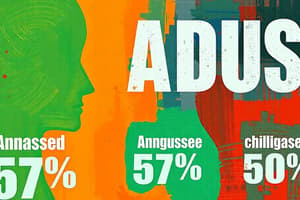Podcast
Questions and Answers
Of all child abuse fatalities, ____% were infants younger than 1 year old.
Of all child abuse fatalities, ____% were infants younger than 1 year old.
46.6
____% of all child abuse fatalities were children less than 3 years old.
____% of all child abuse fatalities were children less than 3 years old.
70.6
What is the movement at 2 months?
What is the movement at 2 months?
Head up 45 degrees.
What is the movement at 4 months?
What is the movement at 4 months?
What is the movement at 6 months?
What is the movement at 6 months?
What is the movement at 9 months?
What is the movement at 9 months?
What is the movement at 12 months?
What is the movement at 12 months?
Why is abuse so common under 12 months?
Why is abuse so common under 12 months?
What is important to evaluate in potential child abuse?
What is important to evaluate in potential child abuse?
What are normal bruises in neonates?
What are normal bruises in neonates?
Is a frenulum tear consistent with accidental injury?
Is a frenulum tear consistent with accidental injury?
Do most kids who don't cruise bruise?
Do most kids who don't cruise bruise?
Where are bruises found in babies that walk?
Where are bruises found in babies that walk?
What else can cause bruising in young kids?
What else can cause bruising in young kids?
What is a congenital dermal melanocytosis?
What is a congenital dermal melanocytosis?
What is the bruising clinical decision rule (BCDR)?
What is the bruising clinical decision rule (BCDR)?
What is the TEN4 FACESp rule?
What is the TEN4 FACESp rule?
Any bruising at all in an infant ____ months old and younger is suggestive of abuse.
Any bruising at all in an infant ____ months old and younger is suggestive of abuse.
What does TEN stand for?
What does TEN stand for?
What does FACES stand for?
What does FACES stand for?
What is a patterned injury?
What is a patterned injury?
What is a sentinel injury?
What is a sentinel injury?
What happens when a sentinel injury is identified?
What happens when a sentinel injury is identified?
What are challenges in evaluating sentinel injuries?
What are challenges in evaluating sentinel injuries?
What is bias in child abuse cases?
What is bias in child abuse cases?
What is bias in recognition and reporting abuse?
What is bias in recognition and reporting abuse?
Flashcards are hidden until you start studying
Study Notes
Child Abuse Statistics
- 46.6% of child abuse fatalities involve infants under 1 year old.
- 70.6% of fatalities are in children less than 3 years old.
Developmental Milestones
- At 2 months: infants can lift their heads to a 45-degree angle.
- At 4 months: infants can roll over and sit with support.
- At 6 months: infants can sit without support.
- At 9 months: infants can cruise.
- At 12 months: infants can walk.
Vulnerability Factors
- Infants under 12 months cannot communicate, making them more susceptible to hidden abuse.
- Many may be too immature to sustain injuries independently.
Injury Assessment
- Understanding a child's developmental ability is crucial in assessing potential abuse-related injuries.
- Not all bruising in neonates is indicative of abuse; normal bruising depends on age and development.
Bruising Patterns in Infants
- A frenulum tear is typically consistent with accidental injury.
- Generally, children who do not cruise do not bruise.
- Bruising in walking infants occurs primarily on the front of the body, especially over bony prominences, with no bruises on the back or diaper region.
Other Causes of Bruising
- Conditions like bleeding diathesis and childhood cancers may lead to unexplained bruising.
Congenital Dermal Melanocytosis
- Known as Mongolian spots, these are common birthmarks that fade, mostly occurring in Asian and Black children.
Bruising Clinical Decision Rule (BCDR)
- A tool designed to identify bruising characteristics to screen children at high risk for abuse, known as TEN4-FACESp BCDR.
TEN4-FACESp Components
- TEN stands for Torso, Ear, Neck with associated risks of bruising.
- FACES details specific areas: Frenula, Angle of the Jaw, Cheek, Eyelid, Sclera, and patterned injuries which may indicate abuse.
Sentinel Injuries
- Minor injuries in non-mobile infants that are suspicious of abuse and can serve as indicators for potential future harm.
- High prevalence of sentinel injuries in abused children (27.5%), with 80% being bruises.
Response to Identified Sentinel Injuries
- Immediate assessment and thorough examination in the hospital.
- Conduct a full skeletal survey and neuroimaging for injuries not immediately visible.
Challenges in Recognizing Sentinel Injuries
- Injuries may be overlooked or misinterpreted due to bias or caregiver behaviors.
- Some caregivers may downplay injury significance or repeatedly seek care for the injured child.
Bias in Child Abuse Cases
- Racial and family structure biases can lead to missed abuse cases.
- Higher rates of missed abuse in white children (37.4%) compared to non-white (19%).
- Children from intact families show a higher missed rate (40.2% compared to 18.7% in non-intact families).
Studying That Suits You
Use AI to generate personalized quizzes and flashcards to suit your learning preferences.




